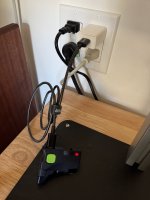bwehman
Member
- Joined
- Mar 21, 2016
- Messages
- 402
So I tried charging the 1010 light on literally every charger I had - integrated ports in wall outlets, MacBook charger, iPhone charger, etc, and thinking I had a bad unit, called Festool and they said they've been having issues with wall bricks that delivered more than 5W. So I found a generic 5W charger we had laying around and tried it out, and sure enough it finally charges.
If your OF 1010 light isn't charging, try that before returning it.
If your OF 1010 light isn't charging, try that before returning it.

